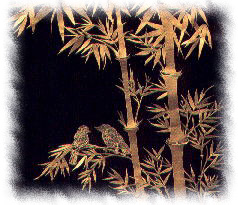Visual Arts -- Paper Cutting
One of China's most popular folk arts is paper cutting. Paper cuttings are not produced by machine, but by hand. They are created either with a pair scissors or a knife. With scissors, up to 8 pieces of paper are fastened together, and then the pattern is cut. With knife cuttings, several layers of paper are put on a foundation of tallow and ashes, and then following a pattern, the artist cuts the pattern into the paper with a knife which is usually held vertically. The advantage of knife cuttings is that considerably more paper cuttings can be made in one operation than with scissors.
Tradition
Paper cutting is a traditional art that has evolved throughout the course of Chinese cultural development. Its origin is closely connected with the invention of paper during the Eastern Han dynasty (25 A.D.-221 A.D.). In the days after its inception, paper was extremely precious, as a result, paper cutting was only popular among court ladies in the royal palaces and houses of nobility. During the 7th through 13th centuries, paper cutting was immensely popular among the commoners. By the 15th century, paper cut art works had become an integral part of the everyday life of the people. Paper cutting also became one of the crafts that every girl was to master and that were often used to judge brides. The influence of paper cutting on Europe and Asia can be traced back to the 7th century as well. The art spread to Japan and then to the Middle East and Europe via the Silk Road, thus leading to the creation of many different styles.
The art of paper cutting has remained unfading in China through the ages principally because its devotees used the skills of knife and scissors to dynamically depict splendid Chinese culture and folk festivals in all its many facets. For example in ancient times, social calls by ordinary folk involved giving paper cuts as gifts and using fancy paper cut likenesses for beautiful adornment to signify auspiciousness. Subsequently, mutual emulation and minute study led to a superb level of paper cutting technique. By later generations, paper cutting ranged from clipping complicated patterns using a tiny pair of scissors to often making cutouts into window decorations, clothes-making stencils, or embroidery patterns for shoes.
As the art passed down through the generations, the mainstream techniques developed many diverse forms, but the themes of the subject matter primarily remained folk motifs, with two-dimensional illustrations as the primary form. The technique they display consists of a combination of trimming with scissors and carving with a knife. The rendering of their visual appearance involves such methods as applying multiple layers of color, folding symmetrically, individually pasting, and uniquely engraving. These different cutting methods could be said to be quite beautiful, but manifestation of the unique, lively beauty of paper cutting still depends on the artistic mastery of every artisan.
Today
During the past century as China experienced successive years of war, the art of paper cutting was on the verge of dying out. Amidst the changes in their lives caused by war, most people had no leisure time to engage in paper cutting. Because of heavy publicity, the art of paper cutting has again received a great deal of attention, and consequently, extremely innovative art work has been created. Today, many valuable ancient paper cutouts are kept in the national museums of these countries.

of Birds and Bamboo |
Nonetheless, Mrs. Yeh feels that Chinese paper cutting art can seek future development. First, she calls on the public to accord due respect for the traditional classic and elegant style rather than cut reproductions and imitations with a knife. Second, she advises artists to explore new themes rather than being confined to the conventional Chinese folk festivals. Third, she has hopes that the art of paper cutting may blend the charm of traditional Chinese painting, the fineness of embroidery, and the form in Western sculpture in order to create a realistic sense of three-dimensional imagery that revitalizes and animates the art form.



 Chinese Culture
Chinese Culture